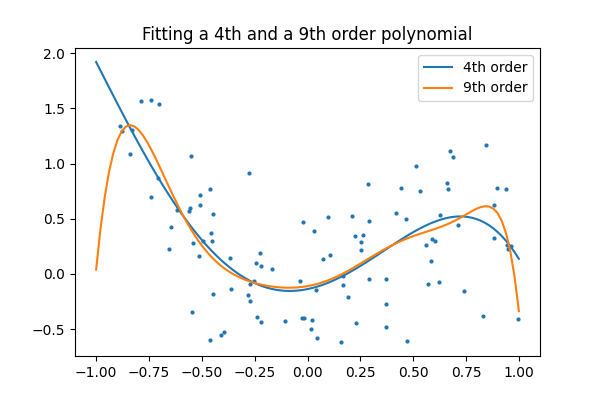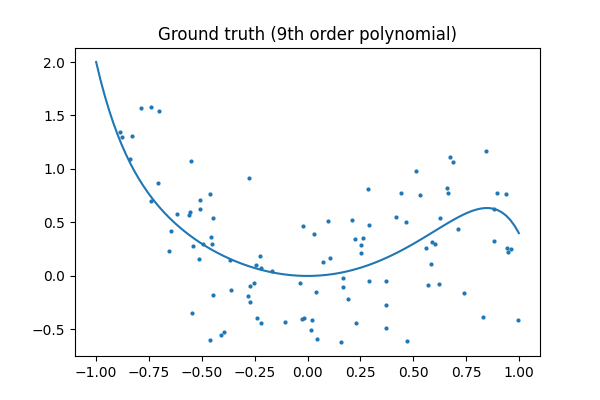Note
Go to the end to download the full example code.
3.4.8.10. Plot fitting a 9th order polynomial¶
Fits data generated from a 9th order polynomial with model of 4th order and 9th order polynomials, to demonstrate that often simpler models are to be preferred
import numpy as np
import matplotlib.pyplot as plt
from matplotlib.colors import ListedColormap
from sklearn import linear_model
# Create color maps for 3-class classification problem, as with iris
cmap_light = ListedColormap(["#FFAAAA", "#AAFFAA", "#AAAAFF"])
cmap_bold = ListedColormap(["#FF0000", "#00FF00", "#0000FF"])
rng = np.random.default_rng(27446968)
x = 2 * rng.random(100) - 1
f = lambda t: 1.2 * t**2 + 0.1 * t**3 - 0.4 * t**5 - 0.5 * t**9
y = f(x) + 0.4 * rng.normal(size=100)
x_test = np.linspace(-1, 1, 100)
The data
plt.figure(figsize=(6, 4))
plt.scatter(x, y, s=4)

<matplotlib.collections.PathCollection object at 0x7f3b1b6d33b0>
Fitting 4th and 9th order polynomials
For this we need to engineer features: the n_th powers of x:
plt.figure(figsize=(6, 4))
plt.scatter(x, y, s=4)
X = np.array([x**i for i in range(5)]).T
X_test = np.array([x_test**i for i in range(5)]).T
regr = linear_model.LinearRegression()
regr.fit(X, y)
plt.plot(x_test, regr.predict(X_test), label="4th order")
X = np.array([x**i for i in range(10)]).T
X_test = np.array([x_test**i for i in range(10)]).T
regr = linear_model.LinearRegression()
regr.fit(X, y)
plt.plot(x_test, regr.predict(X_test), label="9th order")
plt.legend(loc="best")
plt.axis("tight")
plt.title("Fitting a 4th and a 9th order polynomial")

Text(0.5, 1.0, 'Fitting a 4th and a 9th order polynomial')
Ground truth
plt.figure(figsize=(6, 4))
plt.scatter(x, y, s=4)
plt.plot(x_test, f(x_test), label="truth")
plt.axis("tight")
plt.title("Ground truth (9th order polynomial)")
plt.show()

Total running time of the script: (0 minutes 0.173 seconds)